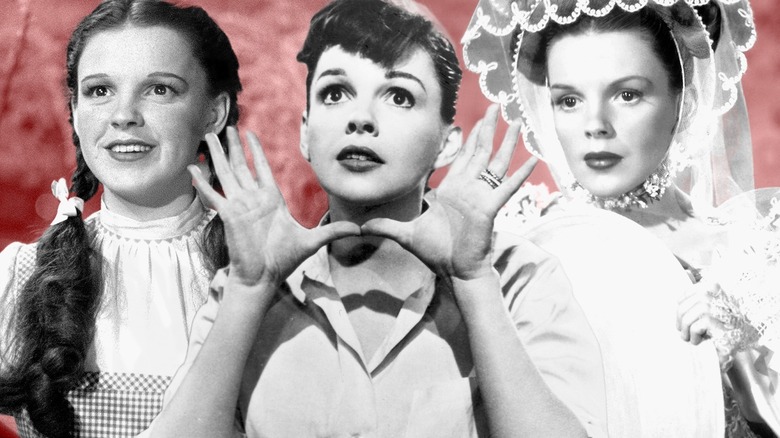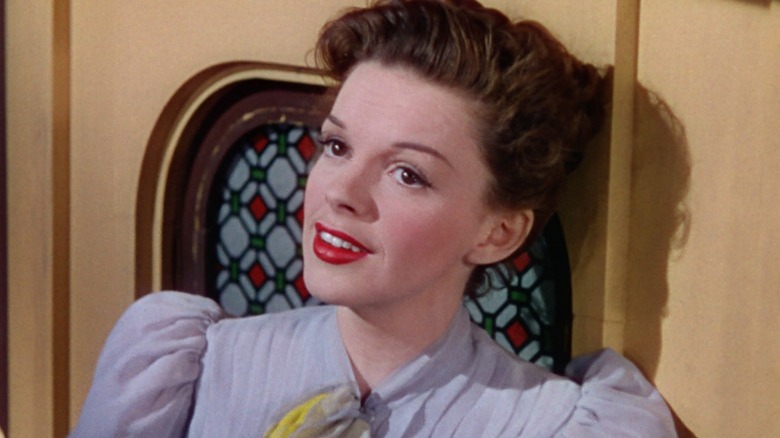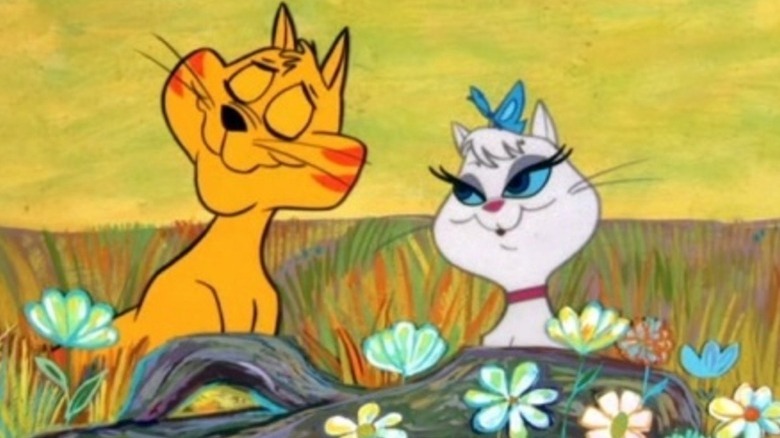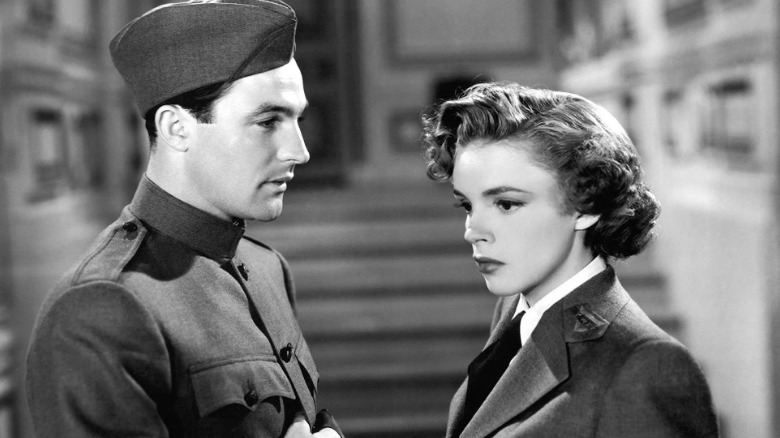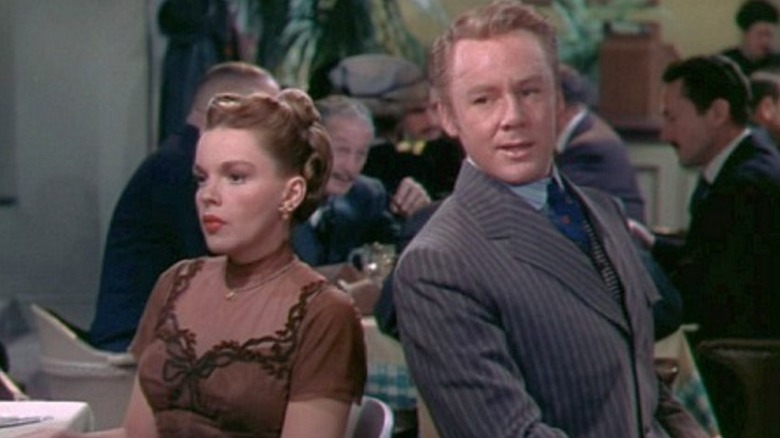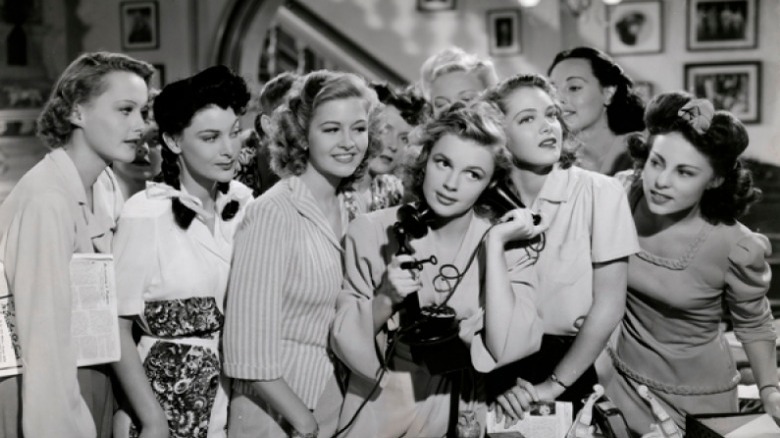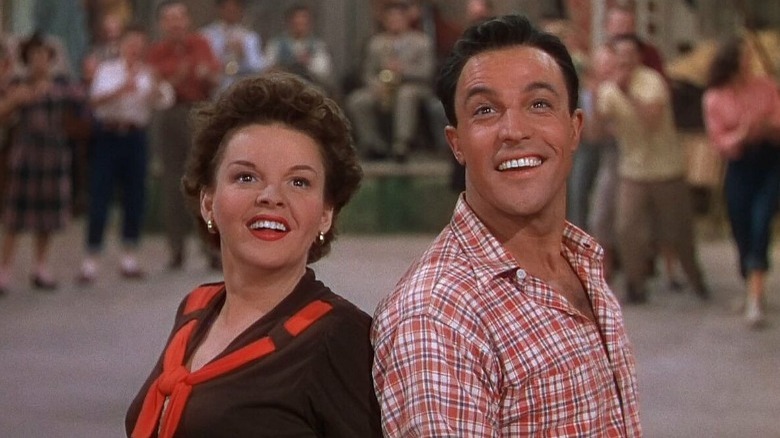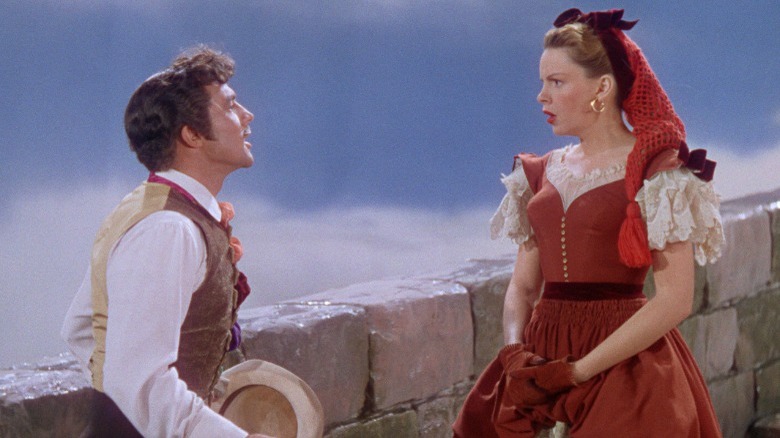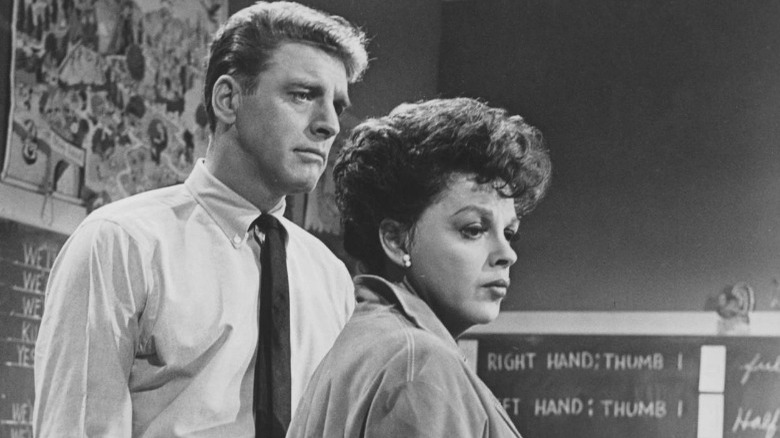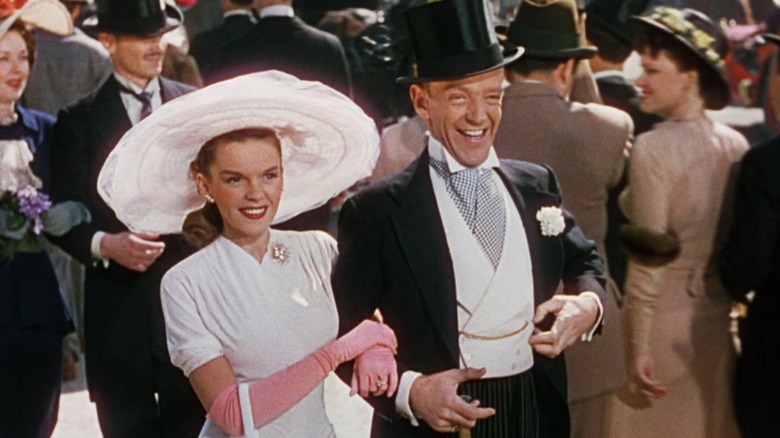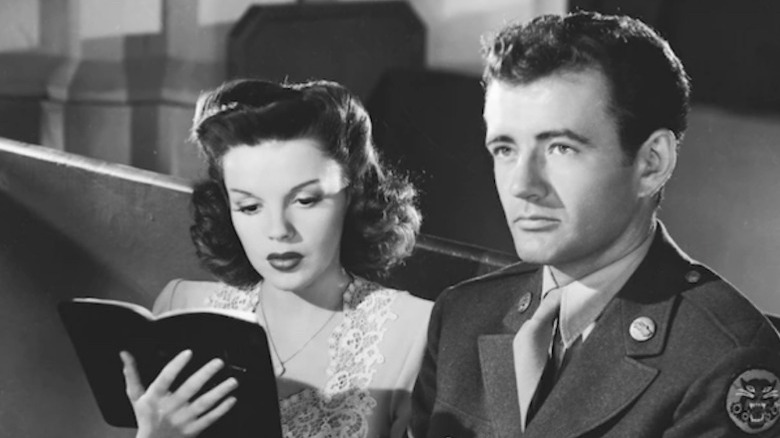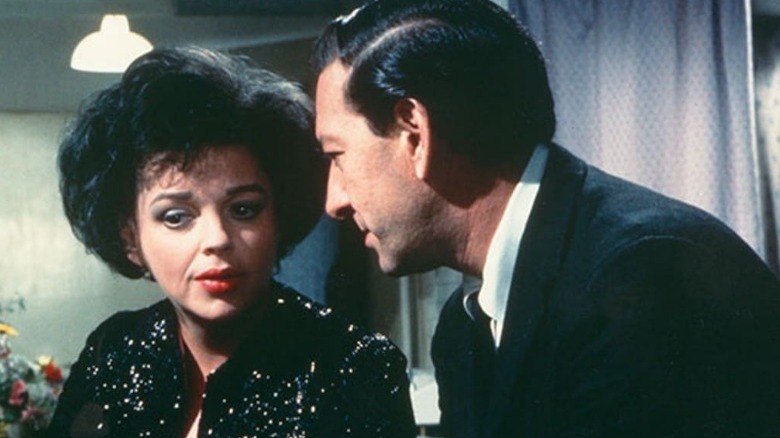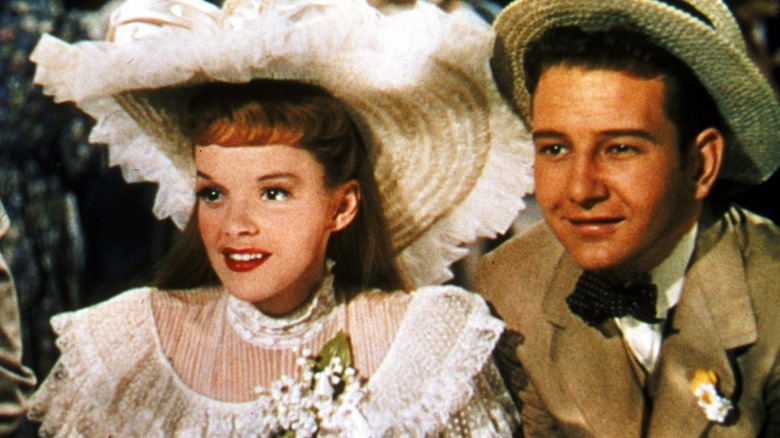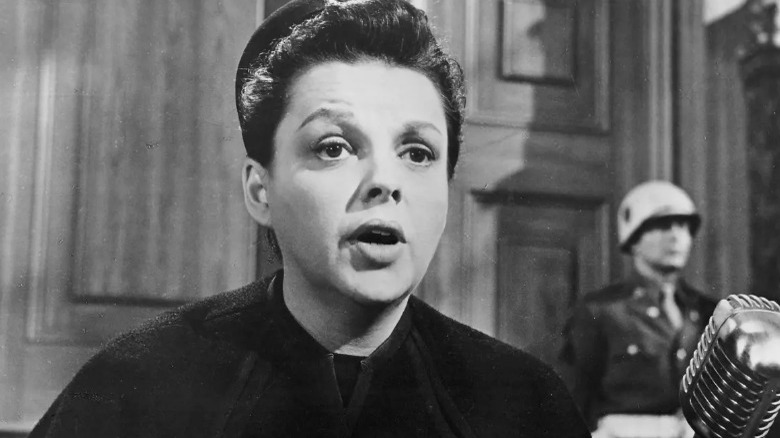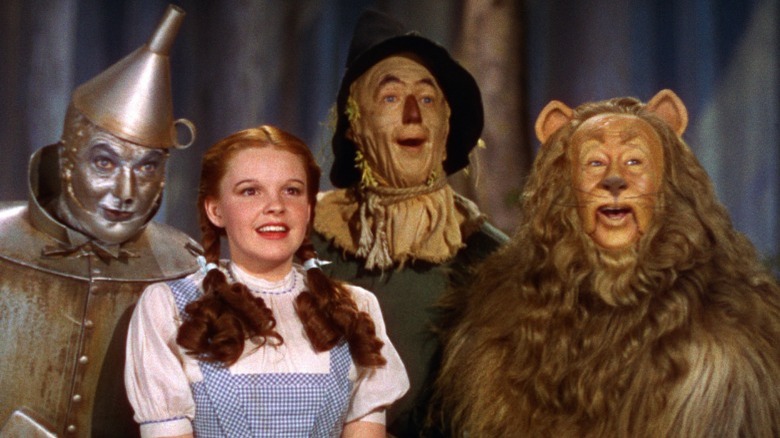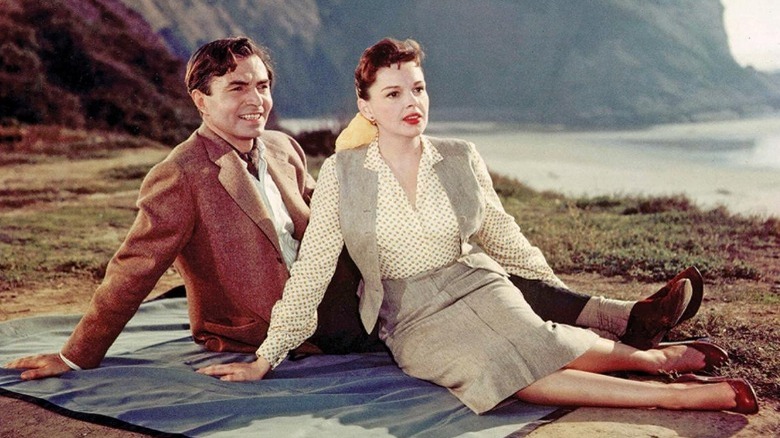The 15 Best Judy Garland Movies, Ranked
In 1939, Judy Garland went over the rainbow, and the world would never be the same again. Garland, who'd first gained major fame singing, dancing, and acting alongside Mickey Rooney, was suddenly catapulted to superstardom. From her roots in vaudeville, Garland had been performing her whole life, and she eventually became one of the world's most beloved stars. Her singing voice is completely unmatched, and it was backed up with intensity, passion, and unparalleled charm. Though her personal history is not without difficulty — and Rene Zellweger won an Oscar for portraying part of that history in "Judy" — Garland is largely remembered as one of Hollywood's most beloved actresses.
Looking through Garland's career, it was her latter years that offered opportunities for rich experimentation. Though she still appeared in musicals, after her MGM contract expired, she boldly took risks, such as starring in an animated feature and an epic courtroom drama. She even led her own variety series that bore her name: "The Judy Garland Show," which ran from 1963-1964. The show provided an opportunity for adoring audiences to really get to know Judy, as well as her unmatched singing talents, like in this stunning rendition of "Happy Days Are Here Again" and "Get Happy" with Barbra Streisand.
It's easy to see why Garland remains legendary long after her passing in 1969. In addition to her gorgeous singing voice, she was always a magnetic screen presence. So let's put on our ruby slippers and look back at her finest accomplishments. These are Judy Garland's 15 greatest movies, ranked.
15. The Harvey Girls (1946)
Susan Bradley (Judy Garland) is off to marry a man she's never met. After answering a lonely hearts ad, Susan boards a cross-country train to meet her beau, but on the way discovers something that'll change her life forever — even more than by marrying a complete stranger! When Susan learns that her future husband is not all he's cracked up to be, she joins up with the Harvey Girls, a group of waitresses she's met on the train. The Harvey Girls aren't just any old waitresses: they're locked in competition with a rival restaurateur, and Susan finds herself at the forefront of it all.
Directed by George Sidney, "The Harvey Girls" is a swell musical with a great cast — including John Hodiak, Cyd Charisse, Virginia O'Brien, and Angela Lansbury as a fierce dance hall girl. It's a far cry from "Murder, She Wrote." The ensemble also includes Ray Bolger, who reunites with Garland after playing the loveable Scarecrow in "The Wizard of Oz." Bolger even gets a great dance sequence that feels reminiscent of his "Oz" character while showcasing some nifty moves.
The film's sense of scale is impressive, especially in the rollicking musical number "On the Atchison, Topeka and Santa Fe," with its sheer panache and visual flair, and hundreds of extras. "The Harvey Girls" as a whole is often too silly for its own good, but Garland shines through as the star she's always been.
14. Gay Purr-ee (1962)
While today it's commonplace to cast major A-list talent in animated movies, it was a big surprise to see a screen legend like Judy Garland take on the role of Mewsette, an adorable feline with dreams of the big city. Yet that's precisely what happens in 1962's "Gay Purr-ee" from UPA, an animation studio that aspired to rival Disney. That didn't happen, but "Gay Purr-ee" comes with a solid pedigree, as "Looney Tunes" icon Chuck Jones and his wife Dorothy Webster wrote it.
The script wisely utilizes Garland's prodigious musical talents, as Mewsette spends as much time singing as she does talking. Despite a pretty thin plot, the film is beautiful: the painted backgrounds stun and wouldn't be out of place in an art gallery. There's also a fabulous sequence in which Mewsette learns about famous classic painters, resulting in a series of striking moments that imagine Mewsette in famous paintings. Ultimately, "Gay Purr-ee" is less than the sum of its parts, but it rates as memorable for its style and as one of the most unlikely entries in Garland's oeuvre.
13. For Me and My Gal (1942)
Garland found a new collaborator in the phenom Gene Kelly, who made his debut appearance in 1942's musical "For Me and My Gal." The pair play vaudeville performers struggling to break through and become bonafide stars. But America joining World War I will change everything for these performers. Kelly's character Harry injures himself to get out of being drafted, an act that mortifies Garland's Jo. He then strives to do something — anything — to get her back.
The war plotline at first feels like an afterthought, but that's far from the case — and a fascinating way to integrate it into "For Me and My Gal." These people aren't invested in the war, and why should they be? They have their own lives to lead, while it's going on overseas ... until it comes to be a part of their own lives, and the war effort takes over entirely.
This marked Garland's first time not playing a juvenile character; she was 19 during production. She's absolutely up for the task. In the brilliant musical number "After You've Gone", shot largely in tight close-ups, Garland goes from jubilation to heartbreak and back again, all expressed through slight facial movements and the song itself. It's a thing of beauty, and particularly surprising in a Busby Berkeley movie, whose numbers typically feature grand, kaleidoscopic sets.
12. In The Good Old Summertime (1949)
Veronica (Garland) and Andrew (Van Johnson) work together at a music shop. They spend hours and hours together, and can't stand each other. However, Veronica and Andrew are in love with people they're communicating with through the mail. Little do they know they're actually writing letters to ... each other. If that all sounds suspiciously familiar, that's because "In the Good Old Summertime" is a musical remake of Ernst Lubitsch's winning rom-com "The Shop Around the Corner," which was also remade as "You've Got Mail" in the '90s.
While it can't quite compare to the wonder of Lubitsch's film, Robert Z. Leonard's "In the Good Old Summertime" is a good ol' time, and Garland just glows, particularly in the wonderful musical number "I Don't Care." The film's final shot also introduces Garland's real-life daughter, Liza Minnelli, walking alongside her mother and making her film debut in this uncredited appearance.
11. Presenting Lily Mars (1943)
While "For Me and My Gal" opened a year earlier, MGM marketed 1943's "Presenting Lily Mars" as an opportunity for audiences to witness former child star Garland in her first adult role. The film's original trailer focused almost entirely on Garland's career, showing clips from her previous films before introducing a new, mature Garland in "Presenting Lily Mars."
Whereas Berkeley's 1942 film gave us Garland's first adult role, Norman Taurog's "Presenting Lily Mars" delivers her first performance as a screen siren. She's immediately presented as a heartbreaker, seductively descending the stars. "I know why you treat me like a child. It's because you're afraid to think of me as a woman," her character says, confirming the transformation from youngster to glamorous actress. Garland portrays (you guessed it) Lily Mars, a gal with big-city dreams; specifically, of being a world-famous Broadway star.
Unfortunately for Lily, she's not particularly talented, but she possesses the drive and determination to succeed anywhere. Garland's star power is on full display as the try-hard fireball Lily. "Presenting Lily Mars" rates as a funny and sweet ode to the value of perseverance and a poignant reminder that there are no small parts, only small actors.
10. Summer Stock (1950)
A twist on the "Let's put on a show" musical, Charles Walters' "Summer Stock" casts Garland as Jane Falbury, a farm owner who finds herself hosting a theater troupe as a favor to her sister Abigail (Gloria DeHaven). Though uneasy about a group of performers taking over her barn, she wisely uses it to lock in free — and desperately needed –work for the farm. Jane begins to fall for the troupe's director Joe (Gene Kelly), who's engaged to her sister Abigail, complicating things considerably.
Of Garland and Kelly's three collaborations, "Summer Stock" most obviously serves as a mere excuse to bring these two incredible talents together. While that's probably the biggest knock against it — and the paper-thin plot is forgettable, to be generous — sometimes you just want to watch extraordinary talents do what they do best, and Walters' film provides an opportunity for Garland and Kelly to do just that. The marketing further made it clear that this was a celebration of Garland and Kelly.
"Summer Stock" delivers several excellent musical numbers, from the charming opener "If You Feel Like Singing, Sing" to the lovely romantic swooning of "You Wou Wonderful You." Kelly also gets to display his astonishing dance gifts when he performs with a newspaper (far more magnificent than it sounds). But it's Garland's rendition of "Get Happy," performed in a luxurious tuxedo jacket and surrounded by suited male dancers, that cements "Summer Stock" as a must-see.
9. The Pirate (1948)
A thoroughly ridiculous movie, and also a great one, Vincente Minnelli's "The Pirate" represented the second collaboration between Kelly and Garland, and also the best. It starts with fabulous period costuming and sets, and then we meet Manuela Alva (Garland), a woman trapped in an engagement to the detestable Mayor Don Pedro (Walter Slezak). When a circus arrives in town, Maneula realizes what it means to truly fall for someone. Circus leader and performer Serafin (Kelly) wins her heart instantly. This infuriates Don Pedro, who tries to have the circus exiled, which results in plenty of absurd hijinks that you have to see to believe.
Though "The Pirate" is perhaps little more than a 102-minute excuse to let loose and go for broke than an actual film, it's clear that both Kelly and Garland are having a blast dancing and singing great Cole Porter songs with reckless abandon. "Be A Clown" features some particularly extraordinary physicality from Kelly — and the pair live it up in a reprise that closes the film. The song proved so good that it was reworked in "Singin' in the Rain" as "Make 'Em Laugh." "The Pirate" is frequently silly, completely wacky, and a whole lot of fun.
8. A Child Is Waiting (1963)
While Garland had a remarkable singing voice, she sometimes shone brightest in roles that required no singing. Okay, "A Child Is Waiting" does involve a little bit of musicality. Garland plays Jean Hansen, who arrives at the Crawthorn Institute as a music teacher. Garland ends up singing alongside her students in a couple of scenes, but the film, directed by John Cassavetes and produced by Stanley Kramer, focuses largely on Garland's dramatic abilities.
At the school, led by Dr. Matthew Clark (a towering Burt Lancaster), the staff teaches children with learning disabilities. Jean quickly becomes a passionate advocate for the kids and develops a particularly strong affinity for one child whose parents haven't visited in more than two years. Jean takes it upon herself to reunite the child with his mother Sophie (Gena Rowlands), much to Dr. Clark's frustration.
Garland shines in a teary performance. She's arresting in her quietest moments and shares terrific (non-romantic) chemistry with Lancaster. While the film's politics are greatly outdated, resulting in an at-times uncomfortable watch, "A Child Is Waiting" clearly has nothing but good intentions and handles challenging subject matter with tact and sensitivity.
7. Easter Parade (1948)
If you ever want a study of what it means to be a superstar, watch the opening of "Easter Parade." Fred Astaire performs two entire musical numbers before a single iota of context is delivered; it's just Astaire dancing and singing away. For most people, this would be downright baffling, but any opportunity to watch a legend like Astaire perform is always well received, and it's the true call of a screen legend. With the musical numbers under our belt, Charles Walters' "Easter Parade" begins in earnest.
Astaire is Don Hewes, a successful dancer whose partner Nadine (Ann Miller) has decided to go solo. Left reeling, Don determines to find a new partner, and he's convinced he can turn anyone into that partner. And that anyone just happens to be Hannah Brown (Garland), who he finds dancing at a bar. He offers her $150 a week (a monumental step up from her current $15 weekly salary). It should surprise no one that the pair eventually fall for one another. The Garland-Astaire chemistry is fantastic, and the romance works better than in most films of its time, with the first kiss feeling particularly special. Not only a genuinely lovely musical, "Easter Parade" is also a Technicolor showcase for some incredibly elegant gowns and other resplendent outfits.
6. The Clock (1945)
A meet-cute turns into a whirlwind romance in Vincente Minnelli's sumptuous romantic drama "The Clock." Joe (Robert Walker, in a very different role from Bruno in "Stranger on a Train"), a soldier on military leave, travels to New York City for the first time. It's there Alice (Garland) trips over him, and the rest is history. Well, it's actually more complicated than that. Alice's roommate is horrified to learn that she has been with a soldier all day, assuming that he only wants one thing from her. Set to meet under the clock at the Astor, Alice defies her friend's advice, and the two embark on two days of getting to know each other before Joe is shipped off to war. Garland and Walker bring a likability and depth that make their courtship believable.
"The Clock" portrays the intimidating scale of Manhattan with gusto, delving into the city's innate beauty (strolls along Central Park) and its ugliness (one of the most obnoxious drunken men you'll ever encounter). Cities are largely what you make of them, places of endless opportunity that can feel terrifying and lonely for the unfamiliar — and what a difference it makes to have someone alongside you. "The Clock" also provides further evidence that Garland didn't need to sing a note to be a wholly enchanting screen presence.
5. I Could Go On Singing (1963)
Despite delivering some jaw-dropping performances in the latter stages of her career, Garland's star had faded greatly in the 1960s. Out of favor with American audiences, Garland attracted an adoring fan base across the pond in the United Kingdom and moved there permanently. Art often imitates life, and that's certainly the case with "I Could Go On Singing," which casts Garland as Jenny Bowman, a singer who finds great success performing in the UK, particularly at the London Palladium. A year later, in 1964, Garland enjoyed enormous success performing at that very venue in real life, recording a live album and a TV special with her daughter, Liza Minnelli.
Jenny isn't just performing in London. The tour provides her a chance to reacquaint herself with her old lover, David Donne (Dirk Bogarde). They had a child together, but Jenny left the child behind with David, and the boy doesn't know his mother's identity and believes himself to be adopted. Jenny finally gets to spend time with her son — too much time, according to David.
Though "I Could Go On Singing" went down in history as Garland's final film role, it's reassuring to know that she left cinema at the top of her game. Her singing is as profound as ever, and her performance feels like she's bearing her soul through Jenny. "I don't want to be rolled out like a pastry, so everyone can get a nice big bite out of me," she tells David in a heartbreakingly vulnerable moment — for Jenny, and likely Garland too.
4. Meet Me in St. Louis (1944)
Something was surely in the air when making the Technicolor smash-hit "Meet Me in St. Louis." Garland and director Vincente Minnelli fell for each other on set and tied the knot a year after. A tremendously joyous movie, "Meet Me in St. Louis" follows the Smith family: mother Anna (Mary Astor), father Alonzo (Leon Ames), daughters Esther (Garland), Tootie (Margaret O'Brien), Rose (Lucille Bremer), and Agnes (Joan Caroll), and son Lon Jr. (Henry H. Daniels Jr.). "Meet Me in St. Louis" is set in the year leading to 1904's St. Louis World's Fair, where a potential family moves to New York and threatens to upset their wonderful storybook lives.
Garland brings an undeniable sense of wide-eyed innocence and sweetness to Esther, a classic All-American character. It's a glorious, warm love letter of a film that brought the world tunes like "Have Yourself a Merry Little Christmas" and "The Trolley Song," which have become key parts of American music. The film is celebratory and uplifting, but Minnelli was too good a director to revel in unabashed optimism, and unafraid to dabble in darker themes that give a more nuanced, relatable edge to the Smith family. There are plenty of reasons "Meet Me in St. Louis" remains so beloved, from the glowing use of Technicolor to the magnificent music, but it's Garland's performance that absolutely stands out.
3. Judgment at Nuremberg (1961)
Possibly the biggest outlier of Garland's career — excluding "Gay Purr-ee," of course — Stanley Kramer's "Judgment at Nuremberg" is also a remarkable film. A World War II courtroom epic is hardly where you'd expect an actress like Garland, but the 1960s provided her an opportunity to really show her dramatic abilities. Tackling a thorny subject with intelligence, the film follows a military tribunal of German judges accused of crimes against humanity for their roles under the Nazis in World War II.
Garland fans are used to seeing her in a leading role, but she only appears for a few minutes in this ensemble drama about the Nuremberg Trials. Like a true star, she makes every second count, with any sense of vanity completely dissolving behind her character, Irene Hoffman. Called to the stand to confess that she lied under oath about having an affair with a Jewish man, Hoffman must relive horrific memories — as the man, who she claims she had an entirely non-sexual relationship with, was executed. With her character under furious pressure from the prosecution, Garland delivers a complicated and emotionally resonant performance.
Kramer's film also boasts of the best casts ever assembled. Alongside Garland, there's Spencer Tracy, Burt Lancaster, Richard Widmark, Maximilian Schell, Montgomery Clift, William Shatner, and Marlene Dietrich. Essential as both a piece of history and entertainment, few films are as thought-provoking as "Judgment at Nuremberg."
2. The Wizard of Oz (1939)
"If happy little bluebirds fly beyond the rainbow, why, oh why, can't I?" sings Garland in "Over the Rainbow," a perfect song that has a remarkable legacy of its own. It appears near the beginning of the exemplary fantasy "The Wizard of Oz," while Dorothy (Garland) lives her humdrum farm life in Kansas. But after a tornado, Dorothy and her dog Toto wind up in the land of Oz in dazzling Technicolor, breaking out from sepia-tinted Kansas in one of cinema's most breathtaking transitions. This begins her quest to return home: all she has to do is follow the Yellow Brick Road ... and face off with a wicked witch and her flying monkeys along the way.
"The Wizard of Oz" has been beloved since its release way back in 1939, and its popularity has only increased over the ensuing decades, including a return to theaters in 2022. It's totally timeless, with inspired art direction, memorable costumes, and some of the best music cinema — or any other medium — can offer. Garland had a few film performances under her belt by 1939, but this is the film that launched her into the stratosphere, and she emerged as one of Hollywood's most in-demand stars practically overnight. Her performance as Dorothy Gale is spirited, vibrant, and thrumming with passion, and through this film, the masses really discovered the indisputable power of Garland's voice. A sensational feast for the senses and an ode to the power of imagination, "The Wizard of Oz" will live on forever.
1. A Star is Born (1954)
By now, you probably know the story of "A Star is Born" very well. It has been adapted four times over the years — the first time back in 1937, in a film starring Janet Gaynor and Frederic March. The story has largely remained the same: an ingenue, after a chance encounter with a male star, becomes an even bigger celebrity. Worse, as her star skyrockets, he fades into obscurity. While each movie offers something different (some are set in the world of film, others in music), none can compare with the brilliance of George Cukor's 1954 masterpiece, a film so completely and utterly sublime that its three-hour runtime flies by.
Thanks to a bracing and resonant script, a commitment to exploring the magnificent highs and moribund lows that come in the quest for fame, and sensational performances by Garland and James Mason, "A Star is Born" is the definitive big-screen look at stardom. Garland's turn as Vicky Lester is a once-in-a-lifetime slice of magic. It's so raw, genuine, and spellbinding. Much of "A Star is Born" draws on Garland's own life and experiences in Hollywood. Frankly, it would be impossible for any other performer to match Garland's visceral honesty. I could (and do) watch her rendition of "The Man That Got Away" and the powerhouse finale "Born in the Trunk" on repeat.
"A Star is Born" isn't just the best of the four adaptations (five, if you count 1932's "What Price Hollywood?"), and it isn't just the best film in Garland's remarkable career. It's one of the greatest films ever made.
